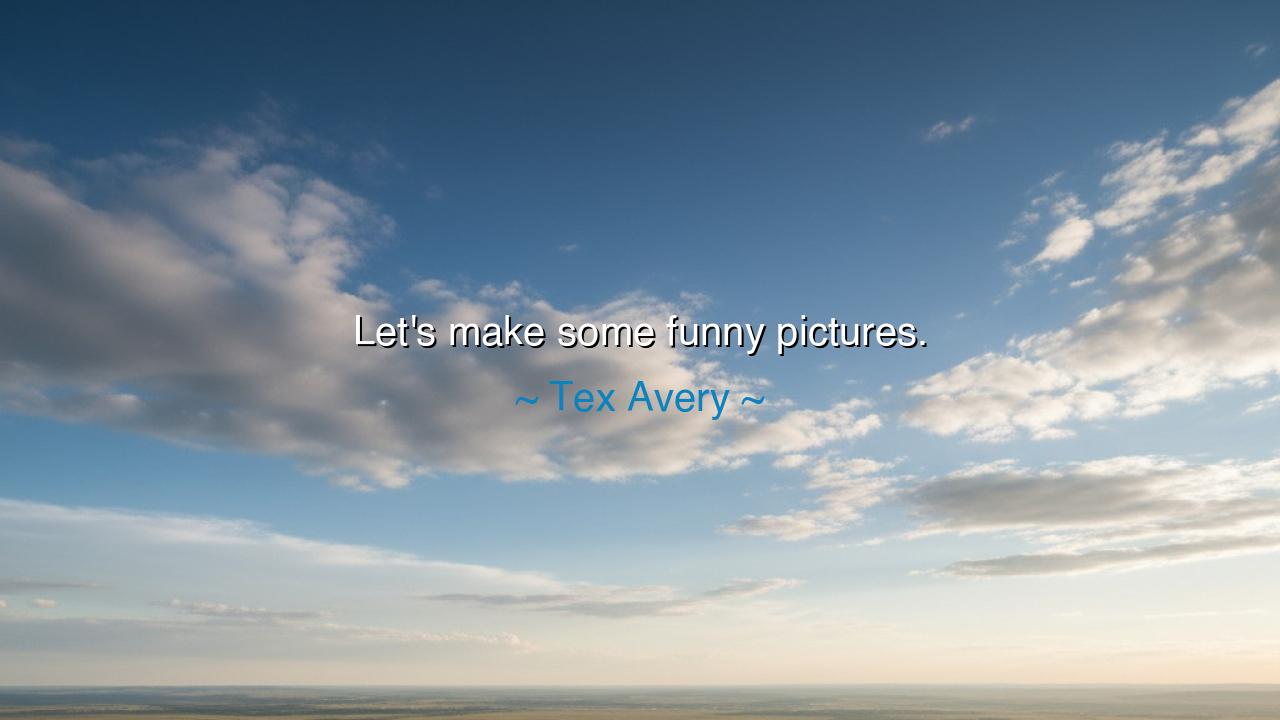
Let's make some funny pictures.






“Let’s make some funny pictures.” Thus spoke Tex Avery, the wild spirit of animation, the rebel of laughter, the dreamer who gave life to wolves that howled at love and rabbits that outwitted the world. In these five humble words lies a spark of divine creation — a call not merely to draw, but to awaken joy, to craft worlds of wonder where imagination reigns and the soul remembers how to laugh. For in saying “funny pictures,” Avery spoke of something sacred: the power to transform the ordinary into the extraordinary through humor, art, and freedom.
In the ancient tongue of the wise, creation was a sacred act — the gods themselves were called makers, sculptors of stars and storytellers of light. Tex Avery, in his time, carried that same fire, though his canvas was the flickering screen and his clay, the line of ink that danced with absurdity. When he said, “Let’s make some funny pictures,” he was not commanding, but inviting — calling upon his fellow artists to join him in the joyous rebellion against dullness and despair. He was saying, in essence: “Let us give the world reason to smile again. Let us remind them that laughter is the language of the soul.”
Avery lived in the age when animation was young, when every frame was drawn by hand and every laugh was earned by sweat and wit. He stood apart from the crowd, daring to break the rules of realism, to stretch the laws of physics and the limits of imagination. To him, the funny picture was more than a cartoon; it was an act of defiance against a world that had grown too serious. His characters could fall off cliffs, be flattened by anvils, explode into dust — and rise again laughing. In their resilience, he revealed a truth older than time: that the spirit that can laugh cannot be destroyed.
Consider his creation of the Wolf and Red Hot Riding Hood — a story at once mischievous and profound. The Wolf, wild-eyed and foolishly enamored, embodied every exaggerated human desire, while Red was the song of temptation itself. Yet beneath the howls and the hammering hearts was a mirror of our nature — exaggerated, yes, but lovingly so. Avery’s genius was in showing that humor is the truth seen through the eyes of madness. He invited us to laugh at our own folly, to recognize in absurdity the wisdom of release. His “funny pictures” were not mere entertainments; they were parables drawn in laughter.
So when Tex Avery spoke his simple phrase, it was not with vanity, but with purpose. He understood that the act of creation need not be grand to be divine. Sometimes, the noblest thing one can do is to make another person laugh. To draw a smile is to heal the heart; to make someone forget their sorrow, even for a moment, is to perform a small miracle. In the dust of the Great Depression and the smoke of war, his funny pictures brought light where there was darkness, reminding the weary that joy is still possible — that even in madness, beauty can thrive.
The ancient poets would have understood him. For what is laughter, if not the echo of creation’s first joy? The world began not in silence, but in energy, in the bursting laughter of the universe unfolding. Tex Avery’s art was a continuation of that cosmic jest — a reminder that existence itself is a dance between chaos and delight. To laugh at the ridiculous is to acknowledge the divine comedy of being alive, where every fall becomes an opportunity to rise again.
Therefore, my friend, take these words as a gentle commandment: make some funny pictures. You need not be an artist of pen or brush — for life itself is your canvas. Create joy where you can. Be unafraid to be absurd, to be playful, to be bold in your imagination. In a world that forgets to smile, even a small act of laughter is an act of rebellion. Draw your “funny pictures” with kindness, with courage, with wonder. For in doing so, you join the lineage of creators — those who, like Tex Avery, have dared to turn the pain of the world into something worth laughing about. And that, dear soul, is the truest art of all.






AAdministratorAdministrator
Welcome, honored guests. Please leave a comment, we will respond soon